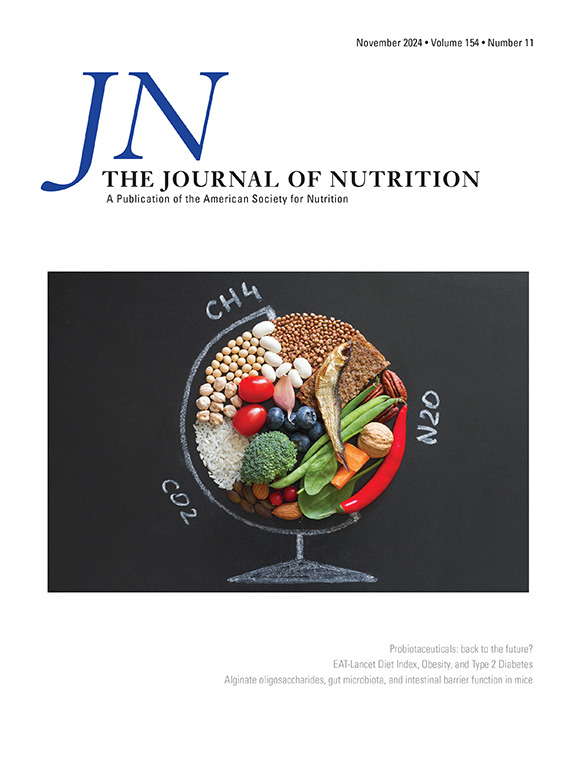Performance of a Food Frequency Questionnaire for Estimating Ultraprocessed Food Intake According to the Nova Classification System in the United States NIH-AARP Diet and Health Study
IF 3.7
3区 医学
Q2 NUTRITION & DIETETICS
引用次数: 0
Abstract
Background
How accurately ultraprocessed food (UPF) intake is measured by food frequency questionnaire (FFQ) is unknown.
Objectives
We evaluated the performance of a 124-item FFQ for estimating UPF intake with Nova.
Methods
In 1311 NIH-AARP Diet and Health Study participants who completed 2 nonconsecutive 24-hour dietary recalls (24HDR) and 2 FFQ, we used 2 methods to estimate UPF intake. First, 4 experts independently matched FFQ items to food descriptions from another FFQ classified previously according to Nova. Discordant descriptions were discussed, and a consensus reached. Second, data from the 1994–1996 Continuing Survey of Food Intake of Individuals were used to match disaggregated FFQ items to Food and Nutrient Database for Dietary Studies (FNDDS) and standard reference (SR) codes. Nova classification of FNDDS and SR codes was based on database linkage. We evaluated FFQ performance using a measurement error model with 2 24HDR as the reference to estimate validity coefficients (ρQ,T) and attenuation factors (λQ). We applied parametric bootstrapping to construct 95% confidence intervals, accounting for the repeated measures structure in the data.
Results
For energy-adjusted, kilocalories from UPF (kcal/d), ρQ,T were 0.50 (0.39–0.61) and 0.44 (0.30–0.59), for males and females, respectively, for the expert consensus method (ECM) and 0.52 (0.40–0.63) and 0.43 (0.29–0.57) for the food code method (FCM). For energy-adjusted, gram weight from UPF (g/d), ρQ,T were 0.65 (0.60–0.71) and 0.66 (0.60–0.72) for the ECM and 0.66 (0.52–0.65) and 0.66 (0.59–0.72) for the FCM; λQ were ≥0.50 for both methods. UPF variables, defined using the ECM and FCM but expressed in the same unit, were highly correlated (r ≥ 0.97).
Conclusions
FCM, performed similarly to ECM but has the potential to standardize UPF exposures across studies because the Nova categorization is assigned at a more granular level through database linkage. UPF intake based on energy-adjusted gram weight outperformed intake based on energy alone.
根据美国国立卫生研究院-美国退休人员协会饮食与健康研究中的Nova分类系统估算超加工食品摄入量的食物频率问卷的性能。
背景:用食物频率问卷(FFQ)测量超加工食品(UPF)摄入量的准确性尚不清楚。目的:我们评估了124项FFQ评估Nova患者UPF摄入量的性能。方法:在n=1311名完成两次非连续24小时饮食回顾(24HDR)和两次FFQ的NIH-AARP饮食与健康研究参与者中,我们使用两种方法来估计UPF摄入量。首先,四位专家独立地将FFQ项目与Nova先前分类的另一个FFQ中的食品描述进行匹配。讨论了不一致的描述,并达成了一致意见。其次,利用1994-1996年美国个人食物摄入持续调查的数据,将FFQ分类条目与膳食研究食品和营养数据库(FNDDS)和标准参考代码进行匹配。FNDDS和SR编码的Nova分类基于数据库链接。我们使用测量误差模型评估FFQ性能,以两个24HDR作为参考,估计有效性系数(ρQ,T)和衰减因子(λQ)。考虑到数据中的重复测量结构,我们应用参数自举构造95%置信区间。结果:对于能量调整,男性和女性专家共识法(ECM)的UPF (kcal/day)、ρQ、T分别为0.50(0.39-0.61)和0.44(0.30-0.59),食品编码法(FCM)的分别为0.52(0.40-0.63)和0.43(0.29-0.57)。能量调整后,ECM的UPF克重(g/d)、ρQ、T分别为0.65(0.60 ~ 0.71)和0.66 (0.60 ~ 0.72),FCM的ρQ、T分别为0.66(0.52 ~ 0.65)和0.66 (0.59 ~ 0.72);两种方法的λQ均≥0.50。使用ECM和FCM定义但以同一单位表达的UPF变量高度相关(r≥0.97)。结论:FCM的表现与ECM相似,但由于Nova分类是通过数据库链接在更细粒度的水平上分配的,因此有可能在研究中标准化UPF暴露。基于能量调整克体重的UPF摄入量优于仅基于能量的摄入量。
本文章由计算机程序翻译,如有差异,请以英文原文为准。
求助全文
约1分钟内获得全文
求助全文
来源期刊

Journal of Nutrition
医学-营养学
CiteScore
7.60
自引率
4.80%
发文量
260
审稿时长
39 days
期刊介绍:
The Journal of Nutrition (JN/J Nutr) publishes peer-reviewed original research papers covering all aspects of experimental nutrition in humans and other animal species; special articles such as reviews and biographies of prominent nutrition scientists; and issues, opinions, and commentaries on controversial issues in nutrition. Supplements are frequently published to provide extended discussion of topics of special interest.
 求助内容:
求助内容: 应助结果提醒方式:
应助结果提醒方式:


